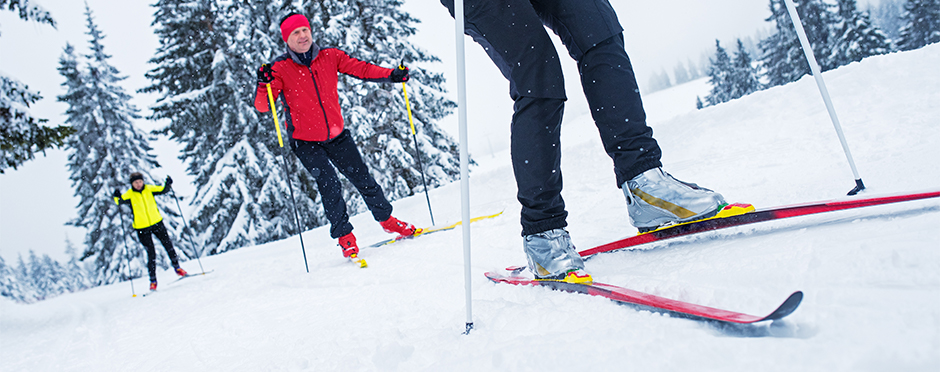
Cross Country Skiing: Benefits and Injury Risk
Leave a CommentCross country skiing or “Nordic Skiing” gets to shine in the spotlight every four years with the Winter Olympic coverage. However, this sport is great every year with many health benefits and a low risk for injuries.
Benefits of Cross Country Skiing
Cross country skiing is a relatively low risk sport and is great for people of all ages. Skiers can perform this activity for fun or for a workout in winter months. Skiing provides both an upper body and lower body workout and is also a great cardiovascular workout.1 It is a great activity for aerobic fitness and calorie burning. Cross country skiing does not stress one muscle group more than others, therefore it is a good option for longer duration workouts with low risk for traumatic injury.1,2
In contrast to downhill skiing, crashes and falls are less frequent in cross country skiing. Downhill skiers generally sustain more severe and complex injuries due to the higher speeds than cross country skiers.3
Possible Injuries in Cross Country Skiing
Although cross country skiing is lower risk than downhill skiing, injuries can still occur. Low back pain can be a concern for cross country skiers due to the repetitive nature of the sport in a forward flexed position.1 Compared to control subjects, cross country skiers reported significantly more back pain than their counterparts, however the long term consequence of this is unknown and may not be an issue.1
For those that are worried about low back pain while cross country skiing, a good core strengthening program can help protect the back. An easy way to strengthen the core at home is by performing planks. Planks require no equipment and activate the abdominal muscles that support and help protect the low back.
There is also a risk of lower body injury in cross country skiing. One study found the foot and the knee to be the most common area reported for injury in cross country skiing.2 Injuries to these areas are generally foot/ankle sprains or sprains of the knee. This could be caused by a fall where the leg is twisted.
Lastly, there is a risk for “skier’s thumb” in cross country skiing. Skier’s thumb is a sprain of the ligament on the inside portion of the thumb. This injury can occur when a skier falls with a pole in hand. There are thumb stabilizers available to help prevent this injury, but skiers can also avoid putting their hands through the ski pole loops unless absolutely necessary.4
An Activity for Every Winter
Nordic skiing is in the spotlight with the Winter Olympics, however it is not only reserved for Olympic athletes. Cross country skiing is a great option for winter workouts. With a relatively low risk for injury, you can enjoy the benefits of this sport every winter.
Should an injury occur, please visit your nearest Athletico for a complimentary injury screen.
Schedule a Complimentary Injury Screen
The Athletico blog is an educational resource written by Athletico employees. Athletico bloggers are licensed professionals who abide by the code of ethics outlined by their respective professional associations. The content published in blog posts represents the opinion of the individual author based on their expertise and experience. The content provided in this blog is for informational purposes only, does not constitute medical advice and should not be relied on for making personal health decisions.
References:
1. Nagle KB. Cross-Country Skiing Injuries and Training Methods. Curr Sports Med Rep. 2015;14(6):442-7.
2. Von Rosen P, Floström F, Frohm A, Heijne A. INJURY PATTERNS IN ADOLESCENT ELITE ENDURANCE ATHLETES PARTICIPATING IN RUNNING, ORIENTEERING, AND CROSS-COUNTRY SKIING. International Journal of Sports Physical Therapy. 2017;12(5):822-832.
3. Ueland O, Kopjar B. Occurrence and trends in ski injuries in Norway. British Journal of Sports Medicine. 1998;32(4):299-303.
4. Macnab, Andrew J., and Robert Cadman. “Demographics of alpine skiing and snowboarding injury: lessons for prevention programs.” Injury Prevention 2.4 (1996): 286-289.
